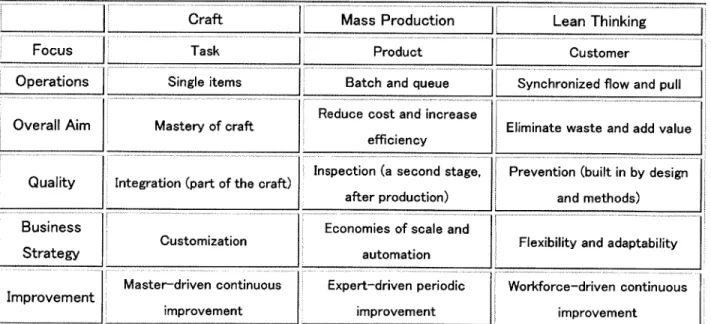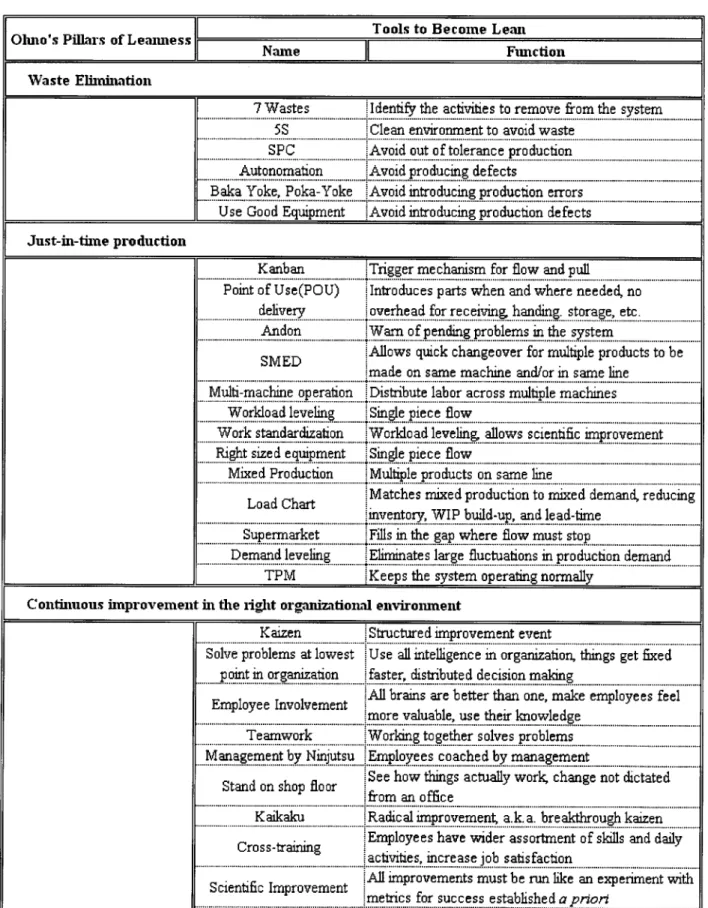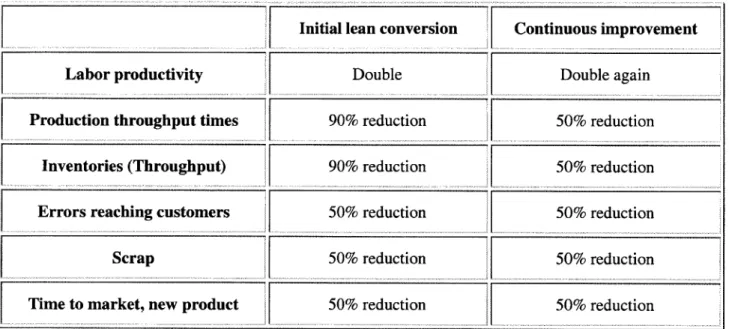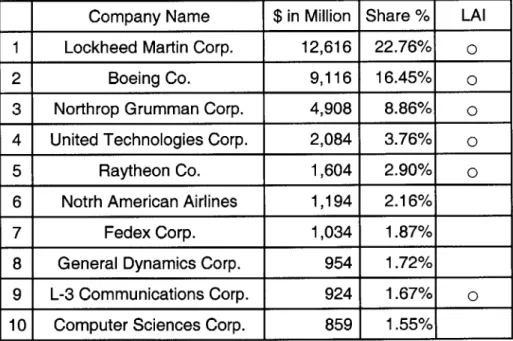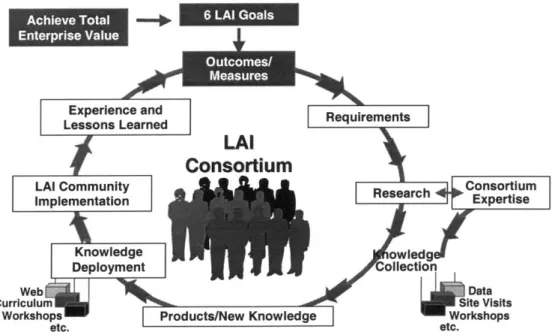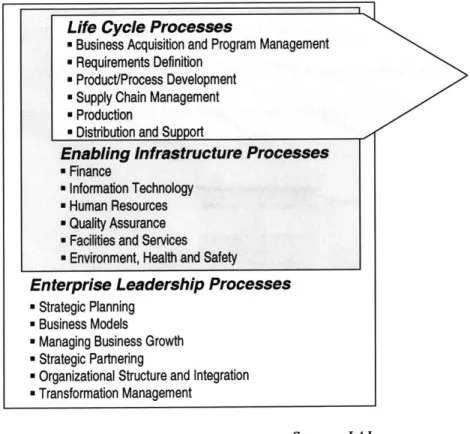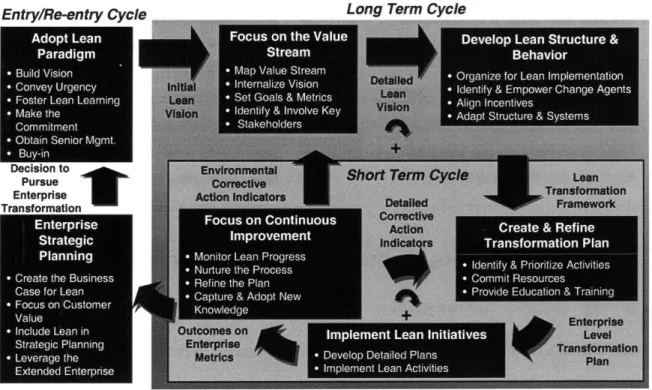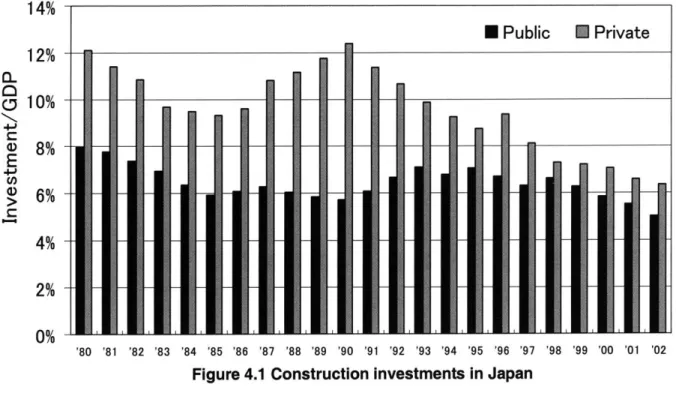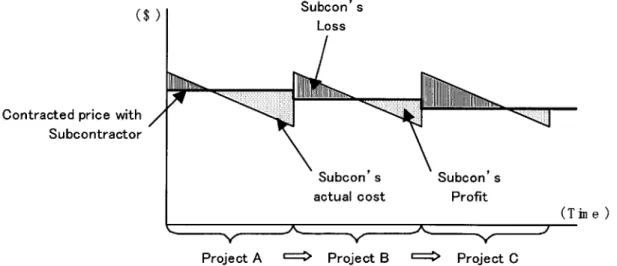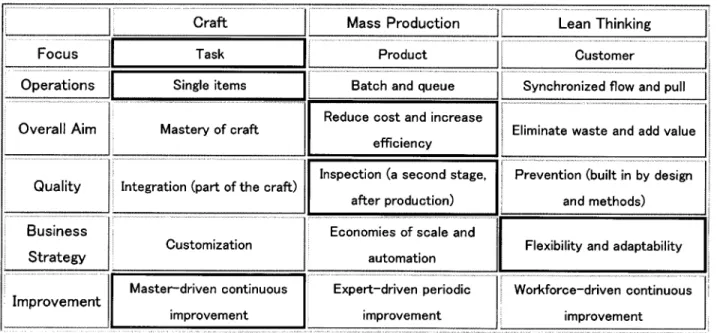Application of Lean Enterprise Concept to Construction Firms in Japan
by
Hiroshi Taguchi
B.E. Civil Engineering
The University of Tokyo, 1997
Submitted to the Department of Civil and Environmental Engineering in Partial Fulfillment of the Requirement of the Degree of Master of Science in Civil and Environmental Engineering
at the
Massachusetts Institute of Technology MA
June 2004
@2004 Hiroshi Taguchi All rights reserved
The author hc::by grants to MIT permission to reproduce and to distribute publicly paper and electronic copies of this thesis document in whole or in part
Signature of Author:
OF TECHNOLOGY
JUN
0 7 2004
IB DEDeprtment of Aivil and Environmental Engineering May 7, 2004 Certified by:
I I
Accepted by:fIid Moaveuzaden James Mason Crafts Professor of Systems Engineering Professor of Civil and Environmental Engineering Thesis Supervisor
... t... ...
Heidi Nepf Chairman, Departmental Committee on Graduate Students
...
Application of Lean Enterprise Concept to Construction Firms in Japan
by
Hiroshi Taguchi
Submitted to the Department of Civil and Environmental Engineering on May 7, 2004 in Partial Fulfillment of the Requirement of the Degree of
Master of Science in Civil and Environmental Engineering
ABSTRACT
Construction firms in Japan are struggling with the change in construction industry environment and need a new business model to meet the change. On the other hand, Japanese manufacturing companies, especially automobile companies, are at their peak standing on their strong production system, which is called the lean production system. The lean production system has its origin in the Japanese automobile industry and has changed the dynamics of international competition of the manufacturing industry. The construction industry is a non-manufacturing business; however, lean concepts could assist in the development of a new business model in the construction context.
This thesis derived lean concepts from the manufacturing industry and examined their applicability for construction firms in Japan, by exploring the business processes of the Japanese construction industry from three perspectives: the production level, the enterprise level, and the extended enterprise level. This thesis revealed that the peculiarities of the construction industry created barriers to reap the full benefit of the lean transformation at the production and the enterprise level. This thesis concluded that the Japanese construction industry should apply lean concepts at the extended enterprise level. A case study of a new airport construction project in Japan supported this conclusion.
Thesis Supervisor: Fred Moavenzadeh
Title: James Mason Crafts Professor of Systems Engineering Professor of Civil and Environmental Engineering
Acknowledgments
Two years in MIT were demanding but exciting experiences for me. Especially, learning about "lean" was one of the most important things. I should pursue this notion through my future professional career. I would like to extend gratitude to all the following:
To Kajima Corporation, for giving me the opportunity to study at MIT and supported my living here in Cambridge.
To my academic and thesis advisor Professor Fred Moavenzadeh, for suggesting me "lean" as the topic for my thesis and giving me information about the research group for related topics at MIT. Without his constant suggestions, I could not have accomplished this thesis.
To all my teammates through the coursework, especially Masashi, Juan, Ted, Cliff, Ronak, for sharing fruitful discussion and giving me new ideas about the future state of the construction industry.
Last but not least, I dedicate this thesis to my beautiful wife, Kimiko. Without her understanding and cooperation, I would not have completed this work.
Hiroshi Taguchi Cambridge, Massachusetts May 2004
Biographical Note
The author, Hiroshi Taguchi, was born June 5, 1973, in Morioka, Japan. He earned Bachelor of Engineering degree in Civil Engineering from the University of Tokyo in 1997 with the Sakuzo Tanabe prize for the best undergraduate thesis in the civil engineering department. He is a registered civil engineer and worked for 5
years in the construction industry in Japan, managing large and complex underground construction projects with the pneumatic caisson method. Since 2002, he has been a graduate student and master candidate at the Construction Engineering and Management Program at MIT.
Table of Contents ABSTRACT ... 3 Acknowledgments ... 4 Biographical Note ... 5 Table of Contents ... 6 List of Figures ... 8 List of Tables ... 9 Chapter 1. Introduction ... 10 1.1 Research Objectives ... 10 1.2 General Approach ... 11
Chapter 2. Lean Production ... 12
2.1 Introduction ... 12
2.2 Lean production principles ... 14
2.3 Lean production mechanisms ... 16
2.4 Benefits of lean production ... 19
2.5 Conclusion ... 21
Chapter 3. Lean Enterprise ... 22
3.1 Introduction ... 22
3.2 Lean Enterprise Concept ... 23
3.3 Extended Lean Enterprise Concept ... 25
3.3.1 Stakeholder ... 28
3.3.2 Value Stream M apping ... 29
3.4 Systematic transform ation to the Lean Enterprise ... 30
3.4.1 LAI's Approach ... 30
3.4.1.2 Transition-to-Lean Roadmap ... 34
3.4.1.3 Lean Enterprise Self Assessment Tool (LESAT) ... 35
3.4.1.4 Summ ary ... 35
3.5 Conclusion ... 35
Chapter 4. Applicability to Japanese Construction Firm s ... 37
4. 1 Introduction ... 37
4.2 Production level ... 40
4.2.1 Production in the Japanese Construction Industry ... 40
4.2. 1. 1 Lack of production capacity ... 40
4.2.1.2 Build-to-order production ... 42
4.2.1.4 Quality by inspection... 44
4.2.1.5 Task-focused production... 44
4.2.2 Position of construction site as a production system ... 45
4.2.3 Applicability of Lean Production Concept to the Construction Site ... 46
4.3 Enterprise level... 48
4.3.1 Enterprise in the Japanese Construction Industry... 48
4.3.2 Applicability of Lean Enterprise Concept to Construction Firms ... 51
4.4 Extended enterprise ... 54
4.4.1 Extended enterprise in the Japanese Construction Industry ... 54
4.4.2 Applicability of Extended Lean Enterprise Concept to the Japanese Construction Industry ... 56
4.5 Conclusion... 59
Chapter 5. Case study...61
5.1 Introduction ... 61
5.2 Project Overview ... 61
5.3 Central Japan International Airport as an extended enterprise ... 64
5.4 Specifying Customer's Value ... 65
5.5 Value Stream M ap of the Central Japan International Airport... 67
5.6 Control the extended enterprise... 69
5.6.1 Cost M anagement... 69 5.6.2 Value Engineering ... 7 1 5.6.3 Strong leadership... 73 5.7 Benefits of lean... 74 5.8 Conclusion... 75 Chapter 6. Conclusion...76 References ... 79
List of Figures
Figure 3.1 LAI's organizational learning
Figure 3.2 Generic multi-program enterprise process architecture Figure 3.3 Principles of a lean enterprise
Figure 3.4 Overarching practices of a lean enterprise Figure 3.5 Transition-to-lean roadmap
Figure 4.1 Construction investments in Japan
Figure 4.2 Construction value stream at the production level Figure 4.3 Contracted price - cost model (current state) Figure 4.4 Contracted price - cost model (future state)
Figure 4.5 Japanese construction firm traditional business processes Figure 4.6 Scope of business by the type of the contract
Figure 4.7 Construction value stream at the enterprise level
Figure 4.8 Construction value stream at the extended enterprise level Figure 5.1 Map of the Central Japan International Airport
Figure 5.2 Surrounding area of Central Japan International Airport Figure 5.3 Source of funds of CJIAC
Figure 5.4 Causal diagram of airport revenue
Figure 5.5 Value stream map of the Central Japan International Airport Figure 5.6 Member of each joint venture
Figure 5.7 Flow chart of cost management
Figure 5.8 Change in the plan of the Passenger Terminal Building Figure 5.9 Waste elimination by the contractor's proposal
List of Tables
Table 2.1 Three types of production system
Table 2.2 Mapping of Ohno's lean philosophies to lean tools and techniques Table 2.3 Benefits of Lean Production
Table 3.1 US Air Force's procurement record in 2003 Table 4.1 Production systems at construction site Table 5.1 Main shareholders of CJIAC
Table 5.2 Landing fee of Major Airports
Chapter 1. Introduction
1.1 Research Objectives
Construction firms in Japan need new business models to meet the change in the
construction industry environment. This industry has a long history and its business model has
not changed drastically because continuous growth in the Japanese economy has supported the
industry until recently. However, this situation won't last long for the future because the Japanese
construction market has already reached the matured stage. Most construction firms suffer from a
declining amount of orders and lower profitability due to the shrinking market and the fierce
competition. To survive this environmental change, currently their basic strategy is changing
their cost structure by improving productivity at their construction sites and reducing selling,
general and administrative expenses and procurement costs, all to improve their bottom line.
However, this strategy is not a long lasting policy and management and employees are stalled
with no way out of this situation because there is no backbone to support the strategy.
On the other hand, Japanese manufacturing companies, especially automobile companies,
are at their peak standing on their strong production system, which is called the lean production
system. The construction industry is a non-manufacturing business; however, lean concepts
This thesis explores principles and mechanisms of lean concepts and examines the applicability of lean concepts to construction firms in Japan.
1.2 General Approach
First, basic ideas and methodologies of lean concepts in the manufacturing industries are explored. Through this process, three types of lean concepts are defined: lean production concept, lean enterprise concept, and extended lean enterprise concept. Then, the applicability of these concepts for construction firms in Japan is examined. Finally, a case study shows what kind of approach should be taken to apply lean concepts to the Japanese construction industry.
Chapter 2. Lean Production
2.1 Introduction
Lean production has its origin in the Toyota Production System in Toyota Motor Company.
Lean production is a completely different concept from mass production. Before the lean
production system, mass production dominated the manufacturing industry. When Toyota made a
strategic decision to pursue a different production system after World War II, automobile
companies in the United States and European countries were already large and enjoyed the
economies of scale of the mass production system. Toyota could not follow the mass production
system because the Japanese domestic automobile market was small and fragmented, the
workforce was in short supply, natural sources were scarce, land was limited, and little capital
was available for investment. To overcome these constraints, Toyota developed a production
system that used less of everything compared with mass production - less human effort in the
factory, less manufacturing space, less investment in tools, and fewer engineering hours to
develop a new product.
At first, the Toyota Production System did not attract other Japanese manufacturing
companies' interest because their business went well during the era of high-speed economic
growth. However, after the energy crisis in 1973, economic growth slowed down and the
started to express considerable interest in the Toyota Production System (TPS).
TPS was introduced with the phrase "lean production system" by James Womack, Daniel Jones, and Dan Roos in The Machine That Changed The World (1991), with the key findings that the best Japanese auto companies had developed a fundamentally different way of making things and that these companies had changed the dynamics of international competition. This book summarized the first five years of work in the International Motor Vehicle Program (IMVP), an MIT-based research institute, and found that Japanese-owned assembly plants in Japan, as well as the U.S. plants of Japanese automakers, enjoyed both higher productivity and higher quality compared with the domestically owned plants in Europe and in the United States, where one could find either high productivity or high quality, but not both.
Table 2.1 shows the difference among three types of production system. We know both craft and mass production systems from our daily life. However, lean production looks unfamiliar at first. In this chapter, we will explore principles and techniques of the lean production concept that will be expanded to the lean enterprise concept later.
Craft Mass Production Lean Thinking
Focus Task Product Customer
Operations Single items Batch and queue Synchronized flow and pull
Reduce cost and increase
Overall Aim Mastery of craft Eliminate waste and add value efficiency
Quality Integration (part of the craft) Inspection (a second stage, Prevention (built in by design after production) and methods)
Business Economies of scale and
Customization Flexibility and adaptability
Strategy automation
Master-driven continuous Expert-driven periodic Workforce-driven continuous Improvement
improvement improvement improvement
2.2 Lean production principles
The main idea of the Toyota Production System is absolute elimination of waste, and this
mantra is supported by two pillars: just-in-time production and autonomation (automation with a
human touch) (Ohno 1988).
Just-in-time production
Just-in-time production is the situation of producing or conveying only the items that are
needed by the next process when they are needed and in the quantity needed. This situation will
create fewer inventories in the factory and help financially and physically as inventories
approach the zero level.
Traditional production management practices that create a production plan for each
production process do not work well to achieve this goal. This is because small changes in each
process create shortages of parts in some areas while unnecessary inventory pile up in other
areas; this does not allow an inventory-free production system.
The breakthrough to achieve just-in-time production was to think about production flow in
the reverse direction: a later process would pull back on an earlier process to pick up only the
right part, in the quantity needed, and exactly when needed. In an earlier process, the number of
parts made would be only that number withdrawn by the next process downstream. By applying
this concept, each production line is highly synchronized to the final assembly line and creates a
dramatically low inventory as a whole.
Autonomation (Automation with a human touch)
Automation is a key part of mass production. Mass production uses high-performance,
high-speed machines to improve productivity. However this system creates many defective
as to prevent this problem. Sakichi Toyoda, the founder of Toyota Motor Company, invented an automatic weaving machine that stopped if any of the threads broke. An autonomated machine is therefore one that can distinguish between normal and abnormal conditions, and if abnormal conditions are detected by the machine, it stops immediately. This basic idea goes beyond the machine level. Production lines are also stopped by line workers when an abnormal condition happens. These approaches prevent defective products and overproduction and stop malfunctions in production lines automatically.
The basis for the idea of absolute elimination of waste is rooted in the following two points: (1) Improving efficiency makes sense only when it is tied to cost reduction. To achieve this, only the things needed must be produced, using minimum manpower.
(2) Look at the efficiency of each operator and each line, then look at the operators as a group, and then at the efficiency of the entire plant (all lines). The efficiency must be improved at each step, and at the same time, for the plant as a whole.
Ohno defined the activities needed to produce the product as divided into real work and waste, and the following equation would hold true whether considering individual workers or an entire production line: Present capacity = work + waste.
Eliminating waste is the true productivity improvement and should be followed by reducing the present capacity. If the elimination of waste is replaced by increased work and present capacity is retained, this only creates new waste. To avoid this situation, Ohno defined seven types of waste in manufacturing.
(1) Overproduction: Producing more than is required or producing something before it is required; any work performed which is not "pulled" by the next production process.
material/parts from a previous operation, tooling, operator readiness, etc., or (b) production
parts waiting in a queue (perhaps in batches).
(3) Transportation: Excessive movement of material/tools between production operations, between facilities, or to and from storage.
(4) Over-processing: Using oversized equipment or equipment not designed for the task at
hand, thereby requiring excess running time and costs; using equipment that has not been
properly maintained, thereby requiring excess processing.
(5) Excessive Inventories: Maintaining stocks of raw materials in excess of current
production requirements; or stocks of finished goods in excess of current customer demand;
or stocks of work in progress as buffers between un-synchronized production operations.
(6) Unnecessary Motion: Human actions/motions beyond the minimum required to achieve the task at hand, i.e., tasks which, in themselves, do not add value.
(7) Defective Products: Parts, materials, sub-assemblies, or products that do not meet specifications and which must be scrapped or reworked to bring them into conformance
2.3 Lean production mechanisms
Various tools and techniques have been developed to realize just-in-time production and
autonomation. Table 2.2 shows these tools and techniques. At first glance, the Toyota Production
System just throws together detailed activities and techniques at production lines. Many
companies tried to implement TPS but failed because they saw it as know-how of the
manufacturing techniques and did not understand the underlying ideas.
TPS has the mechanism of specifying the problem and the production-line-based rapid problem-solving cycle, and both of them enable fast-track improvement within the organization.
Tools to Become Lean Oluio's Pillars of LeanessT
Name
= FFunction
Waste Elimination
7 Wastes . Identify the actiitie s to remove from the system 5S Clean environment to avoid waste
...i...s.
SPC Avoid out of tolerance production Autonomation Avoid pro ducig de fe cts
BDaka Yoke, P oka- Yoke Avoid intro duc ing pro duction errors Use Good Equipment Avoid introducing production defects Just-in-time production
Kanban Trigger mechanism for flow and pull
Point of Use(POU) Intro duc es p arts when and where ne ede d, no delivery overhead for receiving handing. storage, etc.
Andon Warn of pending problems in the system
:Allows quick changeover for multiple products to be Sade on same machine and/or i same line
Multi-machine op eration Distribute labor across multiple machines Worlo ad leveling 1S inge pie ce flow
Work standardization Worload leveling, allows scientific improvement Right sized equipment Single piece flow
Mixed Production Multiple products on same line
Load Chart Matches mixed production to mixe d demand, reducing inventory, WIP build-up, and lead-time
Supermarket IFills in the gap where flow must stop
Demand leveling Eliminates large fluctuations in production demand TPM Keeps the system operating normally
Continuous improvement in the right organizational environnent
Kaizen .Structured improvement event
Solve problems at lowest Use all intelligence in organization, things get fixed point in organization faster distributed decision making
Employee Involvement All brains are better than one, make employees feel [More valuable, use their knowledge
... .... a s... Teamwork Working together solves problems
Management by Ninjutsu !Employees coached by management
sSee how things actually work change not dictated Stand on shop floor fo from an officenofc
Kaikaku IRadical improvement a.k.a. breakthrough kaizen Employees have wider assortment of skills and daily Cross-training
Crsstrinng activ itie s, incre as e jo satis faction
... ... ... ...
All improvements must be run like an experiment with Scintfi Imroemnt metric s for succ e ss e stablishe d a priori
5 Why's Root cause analysis of problems
the production line a sign of waste. Other tools and techniques like andon and 5S also help
problems to be detected. These signals activate continuous improvement and the repetition of
this process makes employees more sensitive to continuous improvement and problem finding.
Once the problem is defined, the problem-solving cycle begins from the production level.
Workforces figure out root causes quickly, then create and evaluate improvement plans, and
finally internalize these solutions in the organization.
What are the necessary conditions to implement the lean production system? There are five
policies management should obey1: Maintain long-term employment
Lean production eliminates waste and improves productivity, and as a result, creates surplus
workforces. If management did not secure long-term employment for their workforces,
continuous improvement would not happen at the production level. Long-term improvement
also creates the environment and educational system to pursue continuous improvement.
Appoint a full-time transformation team
Lean production reveals hidden problems at first, and most of its principles and techniques
are counterintuitive for workforces. Therefore, the failure of implementation is very likely.
Temporary task forces cannot keep the momentum of lean transformation. A special team
should be created to check the implementation regularly.
Management buy-in
Management should be the leader of lean transformation processes. They should create a
shared vision that promotes this process.
Being positive about failures
At the initial stage of lean transformation, there may be numerous failures. Although the lean production system's built-in alarms signal waste within production lines, the problem-solving cycle does not work well at first and, as a result, failures pile up. Therefore, management should remain patient until their workforce learns from experience and the problem-solving cycle starts to work well.
Evaluate the effort that is not connected directly with business performance
Lean transformation needs a culture in which every worker voluntarily suggests improvements. Near-term performance should not be overemphasized, so as to create a good environment for workforce. Trust-based relationships between management and labor should be established.
2.4 Benefits of lean production
After a successful lean transformation, factories typically achieve the following results
(LESAT Facilitator's Guide 2000):
There is a dramatic improvement in responsiveness to customers. Shipments are rarely late; the number of defects reaching customers drop significantly, and overall customer
satisfaction is much greater - thereby increasing market share.
Most of the factory-floor chaos is eliminated. Rather than aisles clogged with batch production orders waiting for processing at banks of identical machines grouped together individual parts and assemblies move smoothly within the Lean factory's synchronized manufacturing cells, never stopping until processing and inspection are completed. Production flow times are reduced by 80 percent to 90 percent. Workstations are well organized and neat; no idle parts or carts clutter the workspace. No expeditors
are needed to push through late production orders by brute force. Storage racks for work-in-progress are largely eliminated. Material handling is simplified, often with manual methods replacing automation. Re-work stations are gone. Scrap is significantly reduced, and the factory floor is much cleaner Labor productivity is double or triple that of the past. Production control systems and their associated information systems are greatly simplified.
Shipments from certified suppliers arrive shortly before needed, are organized in the correct sequence, and move directly to the point of use with no need for incoming inspection. Warehouse space for purchased parts and materials is reduced by 80 percent to 90 percent in many cases.
Completed orders are shipped immediately to customers upon completion of the last stage in the internal value chain, rather than accumulating in large warehouses. Orders are shipped to customers in small quantities (often single units) rather than in large lots. The total floor space needed in Lean factories is typically 55 percent to 65 percent of that needed in mass production factories for the same level of production.
Inventory levels at all stages (raw materials, in-process, and finished goods) are dramatically lower, often by greater than 90 percent.
Table 2.3 shows the simple rule of thumb, based on years of benchmarking and observation
in organizations around the world, developed by Womack and Jones (1996). Initial conversion
efforts dramatically reduce production throughput time and inventory level. Continuous
improvement again doubles productivity and reduces other negative indicators by half within two
Initial lean conversion Continuous improvement
Labor productivity Double Double again
Production throughput times 90% reduction 50% reduction
Inventories (Throughput) 90% reduction 50% reduction
Errors reaching customers 50% reduction 50% reduction
Scrap 50% reduction 50% reduction
Time to market, new product 50% reduction 50% reduction
Table 2.3 Benefits of Lean Production
2.5 Conclusion
The lean production system uses less of everything compared with mass production. The best Japanese auto companies developed a fundamentally different way of making things and these companies changed the dynamics of international competition. The lean production system continuously focuses to eliminate seven types of waste: overproduction, waiting, transportation, over-processing, excessive inventories, unnecessary motion, and defective products.
The lean production system is not know-how of the manufacturing techniques. Many companies failed to implement lean production in their factories because they just applied lean techniques without deeply understanding the underlying thought.
The essence of lean production is a fast-track improvement that is enabled by both the mechanism of specifying the problem and the production-line-based rapid problem-solving cycle. Management should keep the momentum for continuous improvement by motivating their workforces. Long-term personnel training and trust-based relationships between management and workforces are the basis of the lean production system.
Chapter 3. Lean Enterprise
3.1 Introduction
What is the Lean enterprise? Lean enterprise is a state of the company that applies the lean
concept to their organizational activities and continuously eliminates waste from inside and
creates value. This notion has evolved since the "discovery" of the lean production concept.
Many manufacturing companies started to implement the lean production techniques in their
factories, and realized amazing improvements in a specific activity in their shop floors. The core
idea of the lean concept is eliminating waste and optimizing the flow of products, and it is
applicable to the flow of business processes too. Many researchers and practitioners defined this
possibility as a new organizational model, called lean enterprise, which enables dramatically
higher level of performance as a whole. (Womack and Jones, 1994) This is the starting point of
the lean enterprise concept.
An extended lean enterprise concept comes from the idea that the lean enterprise concept
can be applied beyond one company. Some lean enterprises realized from their experiences that
they could not reap a full benefit of this effort of being a lean enterprise if their customers and
suppliers were not lean. For example, they operated their production system with lean-production
techniques and dramatically improved their productivity. They also reorganized their business
thinking dominates their supply chain, the supplier cannot provide raw materials as they need,
and orders from customers are always in a batch-and-queue situation. This environment makes it
hard to be a lean enterprise. Therefore, the second possibility mainly focuses on how different
companies in a same value stream can make progress by eliminating wastes within their
relationships.
In this thesis, to make the meanings clear, we distinguish two concepts of lean enterprise by
calling the first concept lean enterprise and the second one extended lean enterprise depending
on its scope of enterprise. In this chapter, two types of lean enterprise concepts will be explored and the methodology of transformation be addressed.
3.2 Lean Enterprise Concept
Lean enterprise consists of an operationally synchronized group of individuals and functions within a given organization and continuously eliminates waste from the inside of the organization to provide a value to the customer and all stakeholders. A single company usually has many functions for operating their business, and each function interacts with other functions. The value created by the company is definitely the result of this interaction. The lean enterprise concept reveals a detailed look of these interactions and eliminates waste from them, and creates the situation where less interaction makes more value. This is a core idea of the lean enterprise concept.
Compared to the lean production concept, the aim of the lean enterprise concept is clear, however, the way to lean enterprise is more abstract. The lean production concept has some
techniques to achieve lean state, and we can measure the improvement of the product flow easily.
The lean enterprise concept also needs this kind of methodology and Womack and Jones
Specify Value
The first step is specifying the value of ends user. This step is important because at the
enterprise level functionalities have a relatively small portion of involvement in their services or
products. By specifying the value at first, each of the employees can make a decision according
to it and avoid suboptimization at each part. This value comes from specific products and
services, with specific capabilities, offered at specific prices to specific customers. An important
point is to ignore existing assets and technologies and to rethink firms on a product or service
basis with strong, dedicated product teams.
Identify the Value Stream
A flow of value, a value stream, is an important idea in order to understand the lean enterprise. The value stream is the specific activities required to design, order, and provide a
specific product, from concept to launch, order to delivery, and raw material into the hands of the
customer. Lean enterprise focuses on a value stream, not just products or services. This change of
focus to a value stream from products or services might be difficult for any organization at first,
because traditional companies are not designed to optimize a value stream within their
organization.
Value stream analysis distinguishes three types of activities: (1) activities which
unambiguously create value, (2) activities which create no value but are unavoidable with current
technologies and production assets, and (3) activities which create no value and can be
eliminated immediately. Activity (3) should be eliminated, and activity (1) and (2) will be
examined to improve the activity and to eliminate waste from them.
Make Value Flow Continuously
Once the wasteful activities are eliminated, the next step is to make the remaining
manufacturing floor. Therefore, we need to look back at the counterpart of this concept to its origin. This 'flow' is identical to the idea of one-piece flow in Lean-production technique. What is the one-piece flow at the enterprise level? By identifying the value stream at the enterprise level, we can understand the route where the value should flow. This process make reorganizing work processes easier by integrating "Functions" and "Departments" in the company into product teams organized along the value stream.
Let Customers Pull Value
Continuous flow in value stream dramatically reduces the time required to go from concept to launch, sale to deliver, and raw material to the customer. It eventually makes possible the situation that the enterprise starts to make products or services when the customer needs them. It means that the company becomes more responsive to change in demand from the customer.
Pursue Perfection
As an organization begins to implement lean principles and practices, it finds that there is no end to the process of reducing effort, time, space, cost and mistakes while offering a product which is ever more nearly what the customer actually wants. By applying the previous four principles each time, the organization gains more and finds more wastes hidden. This reinforcing loop accelerates continuous process of improvement.
3.3 Extended Lean Enterprise Concept
Extended Lean Enterprise is a group of individuals, functions, and legally separate but operationally synchronized companies which continuously eliminate wastes from the inside of this alliance to provide a flow of value to the customer and all stakeholders. The scope of the extended lean enterprise will differ depending on the value they deliver. For example, in the case of personal computer hardware industry, a company provides a PC with customer's desired
functionality and competitive price by applying lean production-technique. This company's view
of value is to deliver the product the customer needs as cheaply as possible, and the scope of
enterprise will be completed within PC manufacturing company. Although a few customers
admit PC's value as a product alone, most customers define the value of their PC by the benefit
they can obtain from using their PC. Therefore, a PC manufacturing company becomes only the
portion of the extended enterprise, and other participants which have relationships with the uses
of PC like the internet service provider, computer Software Company, peripheral equipment
maker, and so on join the enterprise. Personal computer hardware is one of the leading industries
to apply lean-production techniques to their operation. However, from the extended lean
enterprise view, they have more opportunity by reorganizing the relationships with other
participants and create an industry-wide value stream. To achieve this goal, extended lean
enterprise needs some kind of extra control system which will help optimizing the flow of value
that runs through the various participants.
First, participants of an extended lean enterprise are legally separated companies, and there
is no leader at first. Therefore, every extended lean enterprise needs a "team leader". The role of
team leader is to orchestrate the decision to form an enterprise, to pull together the full
complement of participants, and to lead the joint analysis of the total enterprise stream. (Womack
and Jones, 1994)
Second, every participant is free to leave if other participants fail to improve their
performance or refuse to reveal their real situation. In this sense, an extended lean enterprise is
different from the Japanese traditional keiretsu system which usually depends on the
cross-shareholding system to keep their relationships tight.
Finally, participants need to make agreements before they start work together as an
participants may pass along their waste to other participants in the enterprise without creating
any value. The extended lean enterprise should eliminate waste from each company and between
each member company, thus creating additional value. These agreements include target costing, acceptable levels of process performance, rate of continuous improvement, consistent accounting
systems to analyze costs, and formulas for splitting pain and gain.
Target costing
It is important to decide what price the customer will pay for a product and then working
backward to determine how that product can be made so that it also delivers profit. This idea comes from the equation of "Cost = Price - Profit". This means that price is no longer the
summation of cost and profit. Each participant is allocated a target cost to achieve the price the
enterprise will offer to his or her customer.
Consistent accounting systems to analysis costs
Each participant usually uses a unique accounting system to analyze their costs. Even in the
same company, different lines of business use different systems. To measure the activity of extend enterprise as a whole, every participant's accounting systems should be consistent to be on an equal footing. A standard accounting system also makes cost structure transparent to all participants. This transparency has a huge effect on avoiding suboptimization along the value
stream.
Acceptable levels of process performance
As the enterprise takes the step to lean, their total performance is determined by their weakest link in the chain. Therefore, it is important that each participant complies with a minimum requirement for process performance measures, like inventory level, lead time, distance traveled etc, for their portion of the enterprise.
Continuous improvement is the heart of a lean enterprise concept. To keep this momentum
within the enterprise, a rate of continuous improvement is assigned to each participant. In other
words, continuous cost reduction by way of continuous improvement is mandatory to
participants.
Formulas for splitting pain and gain
In the extended enterprise, an upstream company's effort and investment might generate a
downstream company's profit and vice versa. To make formulas for splitting profits and loss of
the lean enterprise it is necessary to avoid pointless conflicts.
3.3.1 Stakeholder
Especially, for an extended lean enterprise, there is a long list of stakeholders from upstream
to downstream of the value stream. From the lean production standpoint, companies ensured
lower costs, higher quality, and better service & delivery solely to their customers by applying
lean principles to their production level. However, we should be concerned about who their
customers are. Most of the participants of the extended enterprise naturally have different visions
and interests for their portion of the value stream, and they are more likely to pursuit their profit
at the expense of the total performance of the enterprise. However, each value stream has profits
and losses responsibility, and this should be prioritized to each company's interest. Therefore, the
big challenge is that the value to all stakeholders should be optimized to maximize the
performance as the extended enterprise.
Optimizing all stakeholders' value is the core idea of the extended lean enterprise. Murman
et al (2002) defined nine types of key stakeholders for lean enterprise: customer/acquirer, end
user/consumer, shareholder, employee/union, corporation, business partner, suppliers, and
Customer or acquirer is the one to whom the enterprise delivers its products or services.
Lean manufacturers usually focus their needs. End user or consumers receive products or
services from the enterprise's customer or acquirers, not directly from the enterprise.
Shareholder provides capital for the enterprise in return for higher expectation of return on investment than debt holders do. An Employee consists of senior management and the
workforce. They are fundamentals of value creation and support its activities. A union may represent some employees. A Union has a different internal governance structure; however, they need to support lean transformation in a given enterprise. A Corporation is the top management who lead the enterprise in the right direction. They need a strong commitment and leadership. A
Business partner provides risk-sharing capital and intellectual property to improve the enterprise's products and services in return for a sustained portion of value created by the enterprise. Supp/iers provide subassemblies, components, or services. In some enterprises, the number of suppliers goes to more than thousands. Society is an important stakeholder with an
interest that the enterprise maintains the environment, provides job opportunities, supports the tax base, and serves as a positive force in the community, the country, and even the global economy. Elected officials, agencies, regulators, special interest groups, or individuals can represent society.
3.3.2 Value Stream Mapping
Within the defined scope of the lean enterprise, we need to make a current state of a value stream map. In this map, we write down all of the steps in the process as it currently operates. This process includes not only material flow but also information flow like a feedback from the customer. By using this map, every participant can see the whole value stream under discussion and agree on its current level of performance. The steps that do not create value should be
eliminated, while steps that are incapable, unavailable, inflexible, inadequate, and under- or
overcapacitized should be perfected. (Womack and Jones, 2003) Then we can create a future
state of the value stream map, and start effort to close the gap between the current and the future
state of value stream map. This process will never end and continue to pursue for perfection.
3.4 Systematic transformation to the Lean Enterprise
A value stream mapping and an optimization of stakeholder's value are two key components to understand the concept of the lean enterprise. Some industries have applied a systematic
transformation to the lean enterprise and developed some tools to transform and control the lean
enterprise.
3.4.1 LAI's Approach
The consortium called Lean Aerospace Initiative (LAI) made a first step to go beyond the
Company Name $ in Million Share % LAI 1 Lockheed Martin Corp. 12,616 22.76% o
2 Boeing Co. 9,116 16.45% o
3 Northrop Grumman Corp. 4,908 8.86% o
4 United Technologies Corp. 2,084 3.76% 0
5 Raytheon Co. 1,604 2.90%
a
6 Notrh American Airlines 1,194 2.16%
7 Fedex Corp. 1,034 1.87%
8 General Dynamics Corp. 954 1.72%
9 L-3 Communications Corp. 924 1.67% o
10 Computer Sciences Corp. 859 1.55%
Table 3.1 US Air Force's
Soume :.D epartm ent ofD efense
lean production around mid-1990s. LAI consists of key stakeholders from the US Aerospace
Industry, government, organized labor, and MIT. Why the US Aerospace industry could have an
enterprise level focus and pursue to transform the total aerospace industry to the lean enterprise?
Some unique organizational structures are the key enabler of this movement. An important point
is that this consortium includes the US Air Force as the member. In fiscal year 2003, the US Air
force used $55 billion as a total for their procurement. Table 3.1 shows that there are strong
relationships among LAI members. Among its prime contractors, LAI member companies
dominated the top five. LAI member companies provide and share their data among their
members, and in return, they can use LAI's tools and knowledge. This environment is good to
create and develop better tools, because researchers have an access to test their tools in the real
world and can get a feedback soon. This industrial-governmental-academia relationships works
as the learning community and accelerate its knowledge cycle faster than if they do it
independently.
Achieve Total
Enterprise Value
Experience and Requirements Lessons Learned LA
t
Consortium
LAI Community Ceerh onsortiumn
Implementation Reerh Expertise
Knowledge owledgx Deployment Collection
Web! Data
Curriculum Site Visits
Workshops Products/New Knowledge Workshops
etc. etc.
Source: LAI
They started to think about a concept of 'lean enterprise' and learned that
"Understanding and creating value for stakeholders is a critical aspect of being a lean
enterprise"
Before this step was made, most lean transformation focused on cost cutting and
suboptimization of one part. LAI defined a 'lean enterprise' as follows
"A lean enterprise is an integrated entity that efficiently creates value for its multiple stakeholders by employing lean principles and practices." LAI also proposed the generic process
architecture of enterprise (Figure 3.2) to make common language about 'enterprise' among the
consortium members.
Life Cycle Processes
Business Acquisition and Program Management
Requirements Definition -Product/Process Development -Supply Chain Management
-Production
-Distribution and Support
Enabling Infrastructure Processes
" Finance
" Information Technology " Human Resources " Quality Assurance " Facilities and Services " Environment, Health and Safety
Enterprise Leadership Processes
-Strategic Planning * Business Models
-Managing Business Growth -Strategic Partnerng
-Organizational Structure and Integration * Transformation Management
Source: LAI
Figure 3.2 Generic multi-program enterprise process architecture
This 'enterprise' architecture consists of 'Lifecycle Processes', 'Enabling Infrastructure
Processes', and 'Enterprise Leadership Processes.' 'Lifecycle Processes' directly contribute to
seems to identical to traditional ones; however, key point is that they focus on an overall product
Waste minimization
Responsiveness to change
Right thing at right place, at right time, and in right quantity Effective relationships within the value stream
Continuous improvement
Quality from the beginning Source: LAI
Figure 3.3 Principles of a lean en
Human-oriented Practices
" Promote lean leadership at all level
* Relationships based on mutual trust and commitment
* Make decisions at lowest appropriate level * Optimize capability and utilization of people * Continuous focus on the customer
* Nurture a learning environment
Figure 3.4 Overarching practices of a
terprise (Murman et al. 2003)
Process-oriented Practices * Assure seamless information flow
" Implement integrated product and process development
" Ensure process capability and maturation * Maintain challenges to existing processes * Identify and optimize enterprise flow * Maintain stability in changing environment
Source: LAI
lean enterprise (Murman et al. 2003)
lifecycle and avoiding suboptimization within each operation. 'Enabling Infrastructure Processes' consists of traditional support functions. A difference in the lean enterprise context is that these support functions should support the 'Lifecycle Processes'. 'Enterprise Leadership Processes' does not show up in the traditional organizational chart, and set the direction for lean transformation of an enterprise.
The next challenge of LAI was to find the principles and practices that will direct the lean enterprise. They expanded the knowledge of 'lean production' from the automobile industry to 'lean enterprise', and developed principles (Figure 3.3) and practices (Figure 3.4).
These principles eventually became the LAI's Lean Enterprise Model (LEM). The LEM
U U U U U U
"has since become a standard reference for consortium members to developing lean enterprise
strategies."
3.4.1.2 Transition-to-Lean Roadmap
Compared to a manufacturing floor, an enterprise is hard to see as a whole. A value stream
map shows a snap shot of the current state of the enterprise and the blue print of the desired state.
However, transforming an enterprise to lean without a route map is difficult. Transition-to-Lean
Long Term Cycle
Source: LAI
Figure 3.5 Transition-to-lean roadmap
Roadmap (Figure 3.5) was created by LAI to give an idea of what steps should we take to
transform an enterprise by applying lean principles and practices. This roadmap tells what the
key factors in implementing the lean enterprise concept are, and an ideal order in which
transformation activities should be performed. This map also gives us an insight why do so many
3.4.1.3 Lean Enterprise Self Assessment Tool (LESAT)
A Lean Enterprise Self Assessment Tool (LESAT) is a capability maturity model developed by LAI to measure the 'leanness' of an organization and its readiness for change. LESAT consists of diagnostic questions for every item in the Transition-to-Lean Roadmap. For every question, five maturity statements were provided, ranging from least capable (Level 1) to world class
(Level5). By measuring differences between the organizations' current and desired future states
in a certain time period, we can measure the progress of the transformation to the lean enterprise. Although we can get a score after each assessment, the process itself is more valuable than score. Through the discussion with other members within the enterprise, the participants can obtain holistic view of their enterprise.
3.4.1.4 Summary
LAI established the systematic method to transform a company to the lean enterprise. They started from creating an organizational learning cycle among influential parties of the aerospace industry. Especially, extensive involvement of owner (the US Air Force) is the key of rapid growth of their methodologies. These methodologies consist of three parts: Best Practices, Implementation, and Assessment. These methodologies are directly applicable to other industries at the enterprise level.
3.5 Conclusion
Lean enterprise continuously eliminates wastes from the inside of this organization to provide a flow of value to the customer and all stakeholders. Various organizations can be a lean enterprise by applying lean techniques which has a root in lean-production techniques. These
techniques can be applied to a non-manufacturing areas of the company (the lean enterprise
concept), and to a group of companies sharing the same value stream (the extended lean
enterprise concept).
Two key parts of the lean enterprise concept are the value stream and the optimization of
stakeholder's value. A lean Enterprise exists along a given value stream and is continuously
improves through the five steps: Specify Value, Identify the Value Stream, Make Value Flow
Continuously, Let Customers Pull Value, Pursue Perfection. Through these processes, a value to
all stakeholders should be optimized to achieve the best result of the enterprise as a whole.
Lean tools are helpful to be the lean enterprise. A Value Stream Mapping gives a snap shot
of the current state and the blue print of the future state to all stakeholders. The
Transition-to-Lean Roadmap gives an idea of how to be a lean enterprise. LESAT shows where
we are on the lean journey. Those tools are developed by LAI and adopted to the aerospace and
Chapter 4.
Applicability to Japanese Construction Firms
4.1 Introduction
Over the past ten years, the Japanese construction industry has been shrinking. Figure 4.1
shows the change in Japanese investments within this industry over a twenty year span.
Following the collapse of the speculation bubble, private companies cut their domestic
construction investment by nearly half. The Japanese government used to make up for a decline
in private construction investments by increasing investments in the public sector. However, the
government cannot continue to afford this type of policy, and so began decreasing investment in
the public sector to improve fiscal balances. Although these investments in the public sector (5%
of GDP in FY2002) are still at a high level compared to other developed countries (2-3% of
GDP), this trend of declining investment in the public sector seems to be unavoidable. Therefore, Japanese construction firms will be confronted by cut throat competition if they do not take a
step in the right direction. There are two directions: one is to pursue new and promising business
areas, and another is to stay with conventional domestic business and make reforms within the
14% 12% 0.. 0
cj
10% -J V 8% E 4-' ch >6% 4% 2% U%7 '80 '81 '82 '83 '84 '85 '86 '87 '88 '89 '90 '91 '92 '93 '94 '95 '96 '97 '98 '99 '00 '01 '02Figure 4.1 Construction investments in Japan
In the first direction, renewal, urban redevelopment, overseas construction, PFI, engineering,
and environmental market could help make up for the shrinkage in the Japanese construction
market. Most Japanese construction firms set out on a journey in this direction as shown below.
"With regard to securing orders, we will concentrate our efforts on such fields as urban revitalization, environment and engineering, renewal, and overseas businesses, while pursuing marketing activities that are responsive to the changing marketplace (Taisei
Corp2).
"Looking ahead, we intend to secure orders and enhance profitability by practicing "Concurrent Engineering" in every project we undertake and by thoroughly implementing quality control and reducing costs at construction sites, while aggressively marketing in the fields of renewal, environment, urban revitalization, and large-scale overseas projects. We will strive to develop a new profit base by promoting
2 Taisei Corp, To Our Shareholders; http://www.taisei.co.jp/english/ir/share.html
PFI (Private Finance Initiative) and engineering businesses while further solidifying our financial position by reducing management costs and emphasizing cash flow
(Obayashi Corp3)."
"The conclusion is clear Shimizu is well positioned with its superior technology, proven reliability and long history of construction results to be a major beneficiary of expected growth in demand in such key market sectors as urban redevelopment, private finance
initiatives, and environmental services and protection (Shimizu Corp4)."
However, there are many new comers for these attractive markets, and not all the
construction firms are capable of following this direction because they often have little
knowledge of them. Competitiveness in these areas is not determined by price, but by the type of
technologies available and by planning capability, and construction/management experience.
In the second direction, however, there is no clear path right now. The market is shrinking
and competitors do not exit the market. Japanese construction firms need new business models to
meet the changes in the construction industry environment, but this industry is naturally resistant
to the influence of other industries, insisting its own production peculiarities. However, this
needs to change.
Previously, the lean production concept shows some techniques that make other industries'
manufacturing facilities more efficient and responsive to change. The lean production concept
expands into the lean enterprise concept, and the lean enterprise concept shows two possibilities
for new organizational models, the lean enterprise, and the extended lean enterprise.
In this chapter, we will explore the applicability of these three concepts for Japanese
construction firms for each standpoint, the production, the enterprise, and the extended enterprise
3 Obayashi Corp, Annual Report 2003; http://www.obayashi.co.jp/english/ir/annual/pdf/ar_03.pdf 4 Shimizu Corp, Annual Report 2003; http://www.shimz.co.jp/english/pdf/ar_2003_04.pdf
levels.
Before going further into this analysis, the word "Japanese construction firms" should be
defined. There are 552,000 of registered construction firms in Japan, as of March 2003. Among
these construction firms, we focus on general contractors with the capability of planning, design,
and research and development because these capabilities are similar to that of manufacturing
companies, which apply lean methodologies in their organization.
4.2 Production level
4.2.1 Production in the Japanese Construction Industry
At the production level, Figure 4.1 shows the construction value stream. Most of activities
take place on the construction site, and construction firm, subcontractors, and suppliers are the
main players there. Construction firms only play a leadership role and organize construction sites
by selecting subcontractors and suppliers under unique conditions. Pre-construction phases such as planning and design are usually beyond the control of construction site. After the bidding
process, construction firms create detailed plans for each task and manage the on-site production
process. Each subcontractor executes tasks under the direction of project management team from
construction firms. Suppliers deliver needed materials in a timely manner. In this fashion, each
participant adds value to the construction product with each task. Currently, relationships among
the participants of the construction process are influenced by a number of production
characteristics.
4.2.1.1 Lack of production capacity
team within the organization. They procure optimal production teams for every project because
every product in the industry needs a one-of-a-kind production system that responds to changes
in the construction market. To do this, construction firms need to focus on developing expertise
in the selection of appropriate subcontractors and learn how to manage the on-site production
team. Once construction firms contract with subcontractors and suppliers, they focus on mainly
the schedules. This may lead to the firm's lack of the knowledge about "true" construction costs.
Construction Firm
Bidding, Detailed Planning,
Design On site management (Quality, Schedule, Cost, Safety)
Planning
Subcon A Subcon B Subcon C Client
rSupplierJ
Construction Site
Figure 4.2 Construction value stream at the production level
Figure 4.3 shows a simple model of the relationships between the contracted price and the
actual cost of similar tasks in hypothetical projects. Construction firms do not change their
($ Subcon' s Loss
Contracted price with Subcontractor
Subcon's Subcon's
actual cost Profit
(T in e)
Project A ' Project B > Project C
contracted-price during a project. Subcontractors reduce their costs during the project A and
make a profit because they improve their productivity by the repetition of the tasks and reduce
the input of their workforce as the project proceeds. An important point here is that this kind of
productivity improvement is not systematic within the construction industry. It relies heavily on
subcontractors' efforts. For the subsequent projects, construction firms have information from the
previous projects, which might force them to reduce the contracted price even with different
sub-contractors. But, if the new subcontractors do not have experience in this task, they have to
start from the scratch and need a greater effort to achieve the productivity levels expected by the
construction firm. The repetition of this kind of business practice leads to the adversarial
relationships between construction firms and subcontractors, and creates a vicious cycle of profit
loss by subcontractors, which in turn creates further tension.
4.2.1.2 Build-to-order production
Construction firms do not start production until they receive the order from the client,
because they cannot predict client's specific needs and given conditions like budget and
regulations. Construction firms make a contract for each project with the specific price and the
construction schedule, or the lead time, with the client. It is important to realize that this
build-to-order style production system in the construction industry is not the result of a desperate
effort to reduce the lead time as in a manufacturing company. It is simply the result of consensus
about the current construction technologies. For both clients and construction firms, it is hard to
imagine constructing a building only a few days after making a contract while reducing the cost
dramatically. However, this is what is happening in the manufacturing industry. The reason that
some manufacturing companies are trying to achieve a build-to-order production system is to
